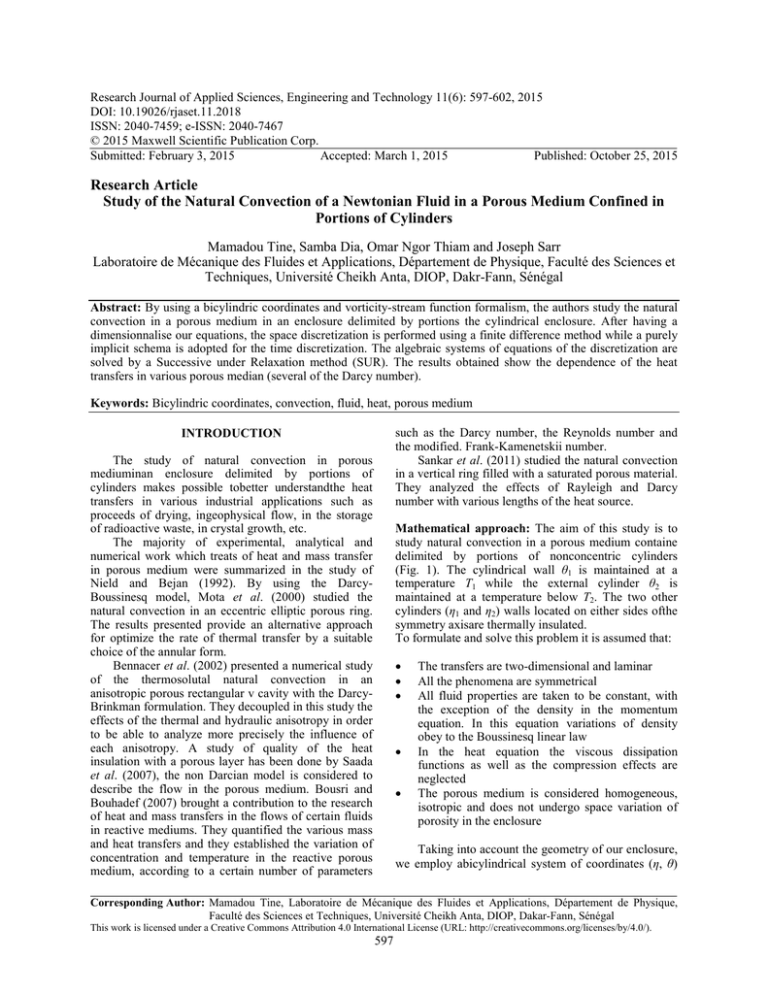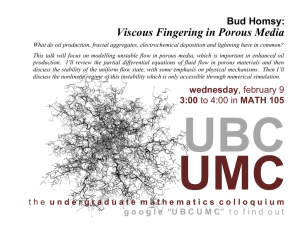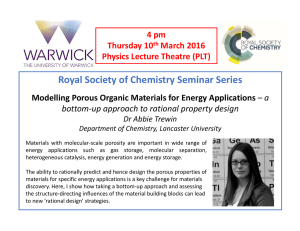Research Journal of Applied Sciences, Engineering and Technology 11(6): 597-602,... DOI: 10.19026/rjaset.11.2018
advertisement

Research Journal of Applied Sciences, Engineering and Technology 11(6): 597-602, 2015 DOI: 10.19026/rjaset.11.2018 ISSN: 2040-7459; e-ISSN: 2040-7467 © 2015 Maxwell Scientific Publication Corp. Submitted: February 3, 2015 Accepted: March 1, 2015 Published: October 25, 2015 Research Article Study of the Natural Convection of a Newtonian Fluid in a Porous Medium Confined in Portions of Cylinders Mamadou Tine, Samba Dia, Omar Ngor Thiam and Joseph Sarr Laboratoire de Mécanique des Fluides et Applications, Département de Physique, Faculté des Sciences et Techniques, Université Cheikh Anta, DIOP, Dakr-Fann, Sénégal Abstract: By using a bicylindric coordinates and vorticity-stream function formalism, the authors study the natural convection in a porous medium in an enclosure delimited by portions the cylindrical enclosure. After having a dimensionnalise our equations, the space discretization is performed using a finite difference method while a purely implicit schema is adopted for the time discretization. The algebraic systems of equations of the discretization are solved by a Successive under Relaxation method (SUR). The results obtained show the dependence of the heat transfers in various porous median (several of the Darcy number). Keywords: Bicylindric coordinates, convection, fluid, heat, porous medium such as the Darcy number, the Reynolds number and the modified. Frank-Kamenetskii number. Sankar et al. (2011) studied the natural convection in a vertical ring filled with a saturated porous material. They analyzed the effects of Rayleigh and Darcy number with various lengths of the heat source. INTRODUCTION The study of natural convection in porous mediuminan enclosure delimited by portions of cylinders makes possible tobetter understandthe heat transfers in various industrial applications such as proceeds of drying, ingeophysical flow, in the storage of radioactive waste, in crystal growth, etc. The majority of experimental, analytical and numerical work which treats of heat and mass transfer in porous medium were summarized in the study of Nield and Bejan (1992). By using the DarcyBoussinesq model, Mota et al. (2000) studied the natural convection in an eccentric elliptic porous ring. The results presented provide an alternative approach for optimize the rate of thermal transfer by a suitable choice of the annular form. Bennacer et al. (2002) presented a numerical study of the thermosolutal natural convection in an anisotropic porous rectangular v cavity with the DarcyBrinkman formulation. They decoupled in this study the effects of the thermal and hydraulic anisotropy in order to be able to analyze more precisely the influence of each anisotropy. A study of quality of the heat insulation with a porous layer has been done by Saada et al. (2007), the non Darcian model is considered to describe the flow in the porous medium. Bousri and Bouhadef (2007) brought a contribution to the research of heat and mass transfers in the flows of certain fluids in reactive mediums. They quantified the various mass and heat transfers and they established the variation of concentration and temperature in the reactive porous medium, according to a certain number of parameters Mathematical approach: The aim of this study is to study natural convection in a porous medium containe delimited by portions of nonconcentric cylinders (Fig. 1). The cylindrical wall θ1 is maintained at a temperature T1 while the external cylinder θ2 is maintained at a temperature below T2. The two other cylinders (η1 and η2) walls located on either sides ofthe symmetry axisare thermally insulated. To formulate and solve this problem it is assumed that: • • • • • The transfers are two-dimensional and laminar All the phenomena are symmetrical All fluid properties are taken to be constant, with the exception of the density in the momentum equation. In this equation variations of density obey to the Boussinesq linear law In the heat equation the viscous dissipation functions as well as the compression effects are neglected The porous medium is considered homogeneous, isotropic and does not undergo space variation of porosity in the enclosure Taking into account the geometry of our enclosure, we employ abicylindrical system of coordinates (η, θ) Corresponding Author: Mamadou Tine, Laboratoire de Mécanique des Fluides et Applications, Département de Physique, Faculté des Sciences et Techniques, Université Cheikh Anta, DIOP, Dakar-Fann, Sénégal This work is licensed under a Creative Commons Attribution 4.0 International License (URL: http://creativecommons.org/licenses/by/4.0/). 597 Res. J. App App. Sci. Eng. Technol., 11(6): 597-602, 2015 Fig. 1: Geometry of the problem (Moon and Spencer, 1971) in which the boundaries of our cavity are given by constant coordinates lines. The passage of Cartesian coordinates to the bicylindrical coordinates is carried out using the following relations: x= b sinh η b sin θ ,y = ,z = z cosh η − cos θ cosh η − cos θ where: 1 ∂Ψ H ∂θ 1 ∂Ψ V =− H ∂η U = (1) The length, velocity, steam function, vorticity and time scale are respectively defined by: where b is the parameter of torus pole. By introducing the stream function and the vorticity, transfers equations and the boundary conditions associated are written in the following dimensionless forms: Stream function equation: Ω=− 1 ∂ 2Ψ ∂ 2Ψ + H 2 ∂η 2 ∂θ 2 b, ν and b 2 α b2 At t = 0 U (η ,θ ) = V (η , θ ) = ψ (η , θ ) = Ω(η ,θ ) = T (η ,θ ) = 0 (2) (5) At t>0 the boundary conditions are the following ones: • On the inner cylinder (θ = θ1 ) : U =V = (3) Heat equation: ∂T U ∂T V ∂T 1 ∂ 2T ∂ 2T + + = 2 2 + 2 ∂t H ∂η H ∂θ H ∂η ∂θ b ,α , The associated initial and boundary conditions of the problem considered are: Momentum equation: ∂Ω U ∂Ω V ∂Ω Pr ∂ 2 Ω ∂ 2 Ω Pr + + = + Ω − ∂t H ∂η H ∂θ H 2 ∂η 2 ∂θ 2 Da C ur Ra * Pr ∂T ∂T − V Ω+ G1 + G2 H ∂η ∂θ Da α Ω= 598 = θ =θ1 −1 ∂ 2ψ H 2 ∂θ 2 T =1 (4) ∂ψ ∂θ ∂ψ ∂η =0 (6) θ =θ1 (7) θ =θ1 (8) Res. J. App App. Sci. Eng. Technol., 11(6): 597-602, 2015 Fig. 2: Variation of the Nusselt number and the minimal of the stream function against Ω= ∂ψ ∂θ = θ =θ 2 ∂ψ ∂η =0 (9) θ =θ 2 −1 ∂ 2ψ H 2 ∂θ 2 (10) ∂ψ U =V = ∂η ∂T ∂η Cf = 2 Pr ∂V . H ∂θ Cf = 1 Cf .ds S∫ ∑ Fi,kj+1 − Fi,kj ∑ Fik, j+1 (11) On the walls η1 and η 2 : Ω= 1 Nu.ds S∫ (15) θ =θ2 T =0 • Nu = Numerical formulation: Equations are integrated numerically using a finite difference method. The spatial discretization is made by a finite difference method. A fully implicit procedure is retaining for treating the temporary derivatives. The resulting algebraic equations were solved by successive under relaxationn method (SUR) (Patankar, 1980). The iterative process is repeats until the criterion of convergence below is satisfied: On the outer cylinder (θ = θ 2 ) : U =V = 1 T − TP Tp = The average temperature inside the enclosure. Fig. 3: Isotherms observed by Sarr (left) at Gr = 0.1.107 and by us (right) at Ra = 107 • Nu = η1 ,η 2 ∂ψ = ∂θ −1 ∂ 2ψ H 2 ∂η 2 η1 ,η 2 ∂T = ∂η =0 (16) where k is the incrementing index of the iterative process and ε r his precision. (12) The grid size selected is equal to (71*71), with uniform grid spacing in both directions, Fig. 2 shows the influence of the grid system according to the instantaneous average Nusselt number Nu on the inner cylinder (θ = θ1) and the minimum value of the streamstream function ψmin, the Rayleigh number is fixed at Ra = 5.106. All the results are obtained with Pr = 0.7 and a time step ∆t = 10-3 is retained to carry out all numerical tests. Refining this time step results in minor changes of the transient patterns. In order to validate our results, we compare them with those of Sarr et al. (2001). In Fig. 3 we can see on the right our isotherms obtained for Ra = 107 and on the η1 ,η2 (13) η =η1 ,η2 =0 ≤ εr (14) η =η1 ;η 2 The local and the average Nusselt number and friction coefficient relative to the lower cylindrical are defined by: 599 Res. J. App App. Sci. Eng. Technol., 11(6): 597-602, 2015 left those observed by experimentally by Sarr et al. (2001) for a Grashof number Gr = 0.1.107. Although the geometries and the boundary conditions are not rigorously identical, the topology of the isotherms is quite similar. In the first instance, theis otherms areal most parallel curves and fit the profile of the hot wall (lower ( wall). The temperature distribution is simply decreasing from the hot wall to the cold wall.. But as we progress in time the isotherms become more and more close to the wall of coordinate θ = θ1, we assist to the formation of a boundary layer. The same phenomenon has been observed by Thiam et al. (2014) in the same sa cavity with no porous medium. The flow fieldis organized in two symmetrical cell srotatingin opposite directions. directions For the Darcy number Da>0.5, >0.5 the effects of the viscous forces will be dominant and thus the flow rate becomes significant. t. By consequent, the streamlines present a strong flow pattern with the swirl principal moves towards the cold wall. I can note that the intensity of convective flow becomes stronger than the value of the Darcy number is increasing. RESULTS AND DISCUSSION The numerical results presented correspond to a Darcy number (Da) varying from 0.1 to 1, the Rayleigh (Ra) and the Prandtl (Pr) are respectively equal to 107 and 0.7. On Fig. 4 we can see the evolution in time of the thermal field (left) and the stream function (right) for various Da. The porous layer constitutes a strong dynamic resistance to the flow due to the Darcian effects which attenuate the thermal effects. Fig. 4: Evolution of isotherms and streamlines for the different Darcy numbers at Ra = 107 600 Res. J. App App. Sci. Eng. Technol., 11(6): 597-602, 2015 Fig. 5: Variation of the average Nusselt number against dimensionless time for various values of Da Fig. 6: Variation of the average friction coefficient aga against dimensionless time for various values of Da When Da = 1,, the penetration of the flow is almost total. The flow in the porous layer and the fluid merges. I tend towards the case of a flow in an entirely fluid cavity. With the values pupils of the permeability, i can expect that the porous medium does not have an influence and that i have a behavior of fluid medium some is the depth of the porous medium. The intensity of the flow increases with the Darcy number and this growth is all the he more high since the Rayleigh number is high. For the values of the Darcy number of the lowest, the porous medium behaves like an impermeable wall. Figure 5 shows us the variation of the average Nusselt number Nu of the active wall according to time for different ifferent Darcy numbers. We can note that when we increase the Darcy number, Nu decrease. This is explained by the fact that the resistance of the flow becomes less and less significant when we increase the Darcy number. That’s why the frictions too on the wall w of coordinate θ = θ1 are more important when Da increase (Fig. 6). CONCLUSION The objective of this study is to numerically study the dynamic and thermal phenomena in an enclosure delimited by portions of cylinders filled with a porous medium. 601 Res. J. App. Sci. Eng. Technol., 11(6): 597-602, 2015 The behavior of the isotherms and the streamlines shows us that the Darcy number doesn’t change significantly the flow pattern. For the values of the Darcy number of the lowest, the porous medium behaves like an impermeable wall and a Darcy number more raises that it has a behavior of the fluid medium. The increase in the Darcy number favors the flow in the porous environment. This medium supports the increase in the effect of the thermal forces and consequently the phenomenon becomes again pseudo convective and results in an increase in the Nusselt number and the decreasing one of the friction coefficient. Cf Da F G1 and G2 cosh η − cos θ and G 2 = G 2 (η , θ ) = sin θ sinh η cosh η − cos θ : Metric coefficient H = Nu q : : : : Ra : Rayleigh number Ra = Nu Pr S t T U ,V 1 cosh η − cos θ Nusselt number Average Nusselt number Prandtl number Pr = ν α Heat flux density g β b4 q ναλ : Surface area of the enclosure : Dimensionless time [ S ] : Dimensionless temperature [ K ] : Dimensionless velocity components in the transformed plane Greek symbols: α : Thermal diffusivity m 2 s −1 β : Thermal expansion coefficient K −1 ν : Kinematical viscosity m 2 s −1 Bennacer, R., A. Tobbal and H. Beji, 2002. Convection naturelle thermosolutale dans une cavite poreuse anisotrope: Formulation de Darcy-Brinkman. Rev. Energ. Ren., 5: 1-21. Bousri, A. and K. Bouhadef, 2007. Etude numérique du transfert de chaleur et de masse dans un cylindre rempli d’un milieu poreux réactifs. Proceeding of the Eurotherm Seminar N°81 Reactive Heat Transfer in Porous Media. Ecole des Mines dAlbi, France. Moon, P. and D.E. Spencer, 1971. Field Theory Handbook. Springer, Berlin. Mota, J.P.B., I.A.A.C. Esteves, C.A.M. Portugal, J.M.S.S. Esperanc and E. Saatdjian, 2000. Natural convection heat transfer in horizontal eccentric elliptic annuli containing saturated porous media. Int. J. Heat Mass Tran., 43: 4367-4379. Nield, D. and A. Bejan, 1992. Convection in Porous Media. Springer, New York. Patankar, S.V., 1980. Numerical Heat Transfer and Fluid Flow. McGraw Hill, NY. Saada, M.A., S. Chikh and A. Campo, 2007. Convection naturelle dans un espace annulaire, horizontal excentré et partiellement poreux. Proceeding of the Congrès Français de Thermique, SFT, Île des Embiez. Sankar, M., P. Youngyong, J.M. Lopez and D. Younghae, 2011. Numerical study of natural convection in a vertical porous annulus with discrete heating. Int. J. Heat. Mass. Tran., 54: 1493-1505. Sarr, J., M. Sall, M.M. Kane, B. Ba and M. Daguenet, 2001. Numerical natural convection in a sectorshaped enclosure. Int. J. Numer. Method H., 11(4): 342-357. Thiam, O.N., S. Dia, P. Faye, C. Mbow and J. Sarr, 2014. Study of the transient natural convection of a newtonian fluid inside an enclosure delimited by portions of cylinders. Res. J. Appl. Sci. Eng. Technol., 7(15): 3069-3074. : Average friction coefficient : Darcy number : Symbolic function representing the vorticity or the temperature : Coefficients G1 = G1 (η , θ ) = 1 − cos θ cosh η H : Thermal conductivity Wm −1 K −1 REFERENCES : Parameter of torus pole : Coefficient de Forchheimer : Friction coefficient Cf λ Ψ : Dimensionless stream function Ω : Dimensionless vorticity Latin letter: b : Time step [ s ] Centre: NOMENCLATURE C ∆t η , θ , z : Bicylindrical coordinates ∆ T : Difference of temperature of the two cylinders 602




